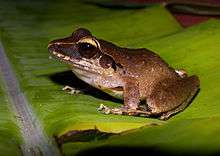Craugastor raniformis
| Craugastor raniformis | |
|---|---|
 | |
| Scientific classification | |
| Kingdom: | Animalia |
| Phylum: | Chordata |
| Class: | Amphibia |
| Order: | Anura |
| Family: | Craugastoridae |
| Subfamily: | Craugastorinae |
| Genus: | Craugastor |
| Species: | C. raniformis |
| Binomial name | |
| Craugastor raniformis (Boulenger, 1896) | |
| Synonyms | |
|
Hylodes raniformis Boulenger, 1896 | |
Craugastor raniformis (common name: robber frog) is a species of frog in the family Craugastoridae. It is found in Colombia and Panama.[2] It is a reasonably common species found in humid lowland and montane forests up to 1,500 m (4,900 ft) asl. It is also common in wet pastureland.[1] Furthermore, it is one of the dominant frogs in abandoned mixed farming areas in the coastal Pacific rainforests in Colombia.[3] This adaptable species is not considered threatened.[1]
Description
Craugastor raniformis is a relatively large frog with a rather pointed snout.[4] Adult females are much larger (snout–vent length 52–74 mm (2.0–2.9 in)) than males (27–43 mm (1.1–1.7 in)).[5]
Behaviour and reproduction
During the day individuals are found on the forest floor concealed in leaf litter. At night they may climb to vegetation to heights of 2.5 m above ground or more. Males and juveniles climb more than the larger females. The call of males has been described as a "ha ha ha ha".[5]
Female Craugastor raniformis have been observed to guard their eggs. Along with other species in Craugastor genus, Craugastor raniformis lays terrestrial eggs that hatch directly into small froglets. Guarding probably protects eggs against predators and fungi.[6]
References
- 1 2 3 Solís, F.; Ibáñez, R.; Jaramillo, C.; Fuenmayor, Q. & Lynch, J. (2004). "Craugastor raniformis". IUCN Red List of Threatened Species. Version 2013.2. International Union for Conservation of Nature. Retrieved 22 April 2014.
- ↑ Frost, Darrel R. (2014). "Craugastor raniformis (Boulenger, 1896)". Amphibian Species of the World: an Online Reference. Version 6.0. American Museum of Natural History. Retrieved 22 April 2014.
- ↑ Cortés-Gómez, Angela M.; Fernando Castro-Herrera & J. Nicolás Urbina-Cardona (2013). "Small changes in vegetation structure create great changes in amphibian ensembles in the Colombian Pacific rainforest" (PDF). Tropical Conservation Science. 6 (6): 749–769.
- ↑ "Craugastor raniformis Boulenger 1896". Amphibians of Panama. Smithsonian Tropical Research Institute. Retrieved 22 April 2014.
- 1 2 Lynch, John D.; Myers, Charles W. (1983). "Frogs of the fitzingeri group of Eleutherodactylus in eastern Panama and Chocoan South America (Leptodactylidae)". Bulletin of the American Museum of Natural History. 175: 481–568.
- ↑ Valencia-Zuleta, Alejandro; Andres Felipe Jaramillo; Fernando Castro-Herrera (2013). "Craugastor raniformis (Robber Frog). Parental Behavior". Herpetological Review. 44 (4): 654–655.
